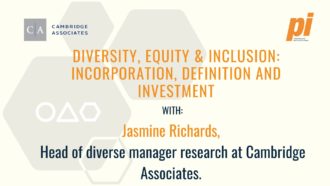Diversity, equity and inclusion (DEI) are becoming more central to institutional investment as the feature on portfolio institutional’s diversity webinar starting on the next page proves.
Further evidence comes from consultancy Chestnut Advisory, which in a study on investor behaviour highlights that more asset owners believe it is important to work with asset managers who prioritise their DEI work.
“From high-net-worth retail investors to the most sophisticated institutions working with individual asset managers, a DEI review is part of every new manager hiring decision today,” said Amanda Tepper, Chestnut Advisory’s chief executive.
“Most diverse wealth investors want their asset managers to offer a culturally diverse workforce and transparency around their DEI policies,” the Chestnut Advisory study said.
DEI and society
“The asset management industry today is not as diverse as the society in which it operates,” added Tepper.
In a US context, this is highlighted by a 2021 Congressional report on diversity in the country’s 31 largest asset managers found that women comprised 26.2% of the executive workforce, while people of colour comprised 16.6%. Only 3% of investment rm executives were black.
Another study by Hedge Fund Research covering 224 institutional portfolios, found that only 29% of portfolio management teams had at least one woman, with just 13% having a female lead or co-lead.
Tepper offered an insight into diverse recruitment at asset managers. “The difficulty recruiting diverse talent to asset managers may be related to the traditional way in which hiring takes place in the industry, that is via personal contact networks,” she said.
“This would explain why managers located in markets with objectively diverse populations tell us: ‘where we are located is an issue’. Managers seeking to increase diversity may need to recruit more creatively than they have in the past and/or expand their networks,” Tepper added.
A good example is the Ontario Teachers’ Pension Plan, which has changed its recruiting strategy to include partnerships with community organisations, such as #10000BlackInterns in the UK, to reach a diverse group of candidates.
Show me the data
Institutional investors are applying their traditional data-driven approach as a rst step in assessing asset manager DEI approaches, Tepper said.
Although this is presenting its own challenges. “A lack of data is probably the biggest barrier,” she added, “which puts investment firms in a potentially difficult position – there are real employee privacy issues and regulations that must be tackled, with different standards around the world”.
Another issue is the lack of investment industry DEI standard, Chestnut Advisory said. But like much in DEI, the issue of data is being addressed. Last year the eVestment database introduced a DEI questionnaire as part of their service, based on the input of many investors and consultants.
And the CFA Institute recommends a DEI protocol and implementation guide. Signatories are being asked to report confidentially on DEI progress to the CFA Institute annually, using the institute’s framework, and the data will be reported on an industry level.
Growth opportunity
In turn, asset managers can best respond to asset owner DEI concerns by treating their own such policies as an enormous growth opportunity, Tepper said. “Winning asset managers need to have a clear and truthful statement of their DEI approach among their sta and in their portfolio holdings as well as in their manager selection criteria,” she added.
And the good news is that asset manager DEI efforts are driving asset flows.
In its research, Chestnut revealed 40% of asset managers highlighted their DEI and ESG efforts are having an impact on their asset flows.
Summing up the challenges asset managers face on this issue, Tepper said: “Asset managers need to have a clear and truthful statement of their DEI approach, both among their staff and in their portfolio holdings and in their manager selection criteria. As the industry has yet to agreed-upon DEI standards and practices, most managers do not have a DEI policy or philosophy. Managers should own that fact rather than try to hide it.”





Comments